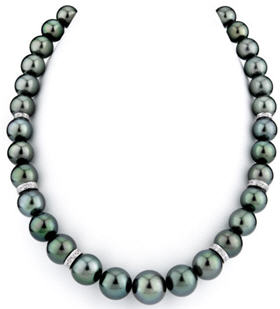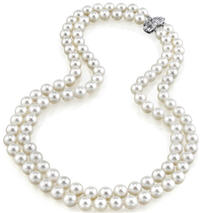A Guide To The Different Types of Pearls
 Women and men who spend time searching for pearl jewelry will soon find that a pearl is never just a pearl. Not only is there a myriad of pearl terminology to learn, but there are also different pearl origins. Also, every single pearl is unique and no two are exactly alike. For a person looking for pearl jewelry, the differences can be undeniably confusing. To help women and men find the perfect pearl for their budget, we’ve created a handy guide to the different types of pearls. We hope that our guide to pearls will help clear the muddy waters of pearl purchasing.
Women and men who spend time searching for pearl jewelry will soon find that a pearl is never just a pearl. Not only is there a myriad of pearl terminology to learn, but there are also different pearl origins. Also, every single pearl is unique and no two are exactly alike. For a person looking for pearl jewelry, the differences can be undeniably confusing. To help women and men find the perfect pearl for their budget, we’ve created a handy guide to the different types of pearls. We hope that our guide to pearls will help clear the muddy waters of pearl purchasing.
Freshwater Pearls
Price: $
Rarity: Most common type of pearl
Origin: Freshwater pearls are the most common and affordable pearls due to the way they are grown. The pearls are cultured in different places in the world in freshwater (lakes, rivers and ponds) using mussels. Freshwater pearls are generally mantle-nucleated, meaning that a tiny piece of a mussel shell is inserted into another mussel to begin the pearl-making process in which the nacre is formed around the inserted mantle.
Saltwater Pearls: Akoya, South Sea, Tahitian
Price: $$
Rarity: Less common than freshwater, more common than South Sea & Tahitian pearls
Origin: Akoya pearls are the most affordable saltwater pearl. The akoya pearl comes from the akoya oyster and was first harvested in Japan, although now much of the harvesting is done in China as well, with only the large akoya pearls originating in Japan. It is the most affordable saltwater pearl, and has a more impressive luster than freshwater pearls.
Price: $$$
Rarity: Very Rare
Origin: Golden and White South Sea pearls are saltwater pearls that are grown inside oysters between the southern coast of China and the northern coast of Australia. Due to the large size of the South Sea oyster, the resulting pearls are the largest of all saltwater pearls. South Sea pearls are also more expensive because the oyster can only grow one pearl at a time, and takes longer to create the pearl than do Akoya oysters or Freshwater mussels.
Price: $$$
Rarity: Very Rare
Origin: Black Tahitian pearls (as pictured in the necklace at top) are grown solely in French Polynesian salt water, and are considered to be the most beautiful pearls in the world. The oyster that produces the Tahitian pearl is very large – around 10 inches across – and is very delicate, which is why the Tahitian pearls are rare and the price is so high. Tahitian black pearl jewelry is extremely desirable, although the ‘black’ label is a bit of a misnomer: Tahitian black pearls come in shades ranging from dark green to gray to purple to chocolate.
We hope our guide to pearl types has given you some insight into the pricing and value of the different kinds of pearls available. Apples of Gold proudly carries pearl jewelry to suit any budget and taste, from freshwater and Akoya to the coveted South Sea and Black Tahitian pearls.
Category: Jewelry Tips














